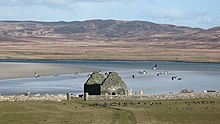Kilnave Chapel
Kilnave Chapel , also Kilnave Church or Gaelic Cill Naoimh or Cill Neimh , is a ruined church near the settlement of Kilnave on the Scottish Hebridean island of Islay . It is located about a hundred meters west of the coast of the Loch Gruinart inlet . On July 20, 1971, Kilnave Chapel was added to the British List of Monuments in Category B.
history
The site was probably a center of religious activity as early as the 1st millennium. A standing cross in the associated cemetery is estimated to date from the 5th or 12th century. However, there is no evidence of any previous buildings or enclosures from this period. It is not known when the present chapel was built. Although the architecture resembles the 12th century Celtic churches on Iona , Historic Scotland puts it around the year 1400.
After the Battle of Gruinart , the defeated members of the MacLean clan are said to have fled to the chapel, which is said to have been set on fire by members of the victorious MacDonald clan . It is not clear to what extent the MacLeans' flight to the chapel actually took place. However, the destruction of the chapel in connection with the battle seems certain. The oldest gravestones from the post-Reformation period date from 1780. It is not clear to what extent only the cemetery or the chapel was used at that time. There is a lack of clarity about the Gaelic name. With Cill Naoimh ( Church of the Holy ) and Cill Neimh ( Nems Church ) there are two possible derivations. Nem's Church contains the name of Saint Nem, who was active in early Christian Scotland, and would corroborate the suspicion of previous buildings in the first millennium.
description
The masonry of the church consists of clay-jointed quarry stone. The 90 cm thick outer walls enclose an inner area of 9.2 × 4.3 m 2 . While rough stone blocks can be found in the lower layers, the material used in the upper layers is much finer. Exceptions are blocks of up to 1.6 m in length on the building edges. The chapel was entered through an opening on the west side, which, similar to the window openings, closes with an arch made of filigree stone material. The stones used were not used in a semicircular shape, but often only have a slight tilt to the vertical. The arched windows were on the east side and at the east end of the south side. Linearly arranged holes are visible in the two gables, which perhaps once served to fix the scaffolding during construction. The raised chancel was on the east side below the window. The outer walls are extremely well preserved, while the roof has collapsed and the ground is grassy.
graveyard
The chapel is almost centrally located on an almost trapezoidal area measuring a maximum of 40 × 28 m 2 . This is enclosed by a quarry stone wall and delimits the historic cemetery. Various cross plates and fragments of crosses were found there. The most important artifact is probably the Kilnave Cross , probably from the 5th century , which, along with the Kildalton Cross , Kildalton Small Cross and Kilchoman Cross, is one of the best preserved standing Celtic crosses on Islay. It is 2.63 m high and rests on a 72 cm high base. To the north of the old cemetery there is a more recent cemetery, which was set up on a rectangular area.
Web links
Individual evidence
- ↑ a b c d Entry on Kilnave Chapel in Canmore, the database of Historic Environment Scotland (English)
- ↑ a b c d Listed Building - Entry . In: Historic Scotland .
Coordinates: 55 ° 51 ′ 36.7 " N , 6 ° 20 ′ 24.5" W.


